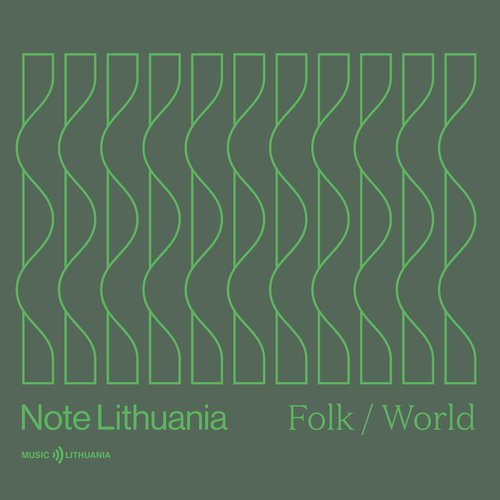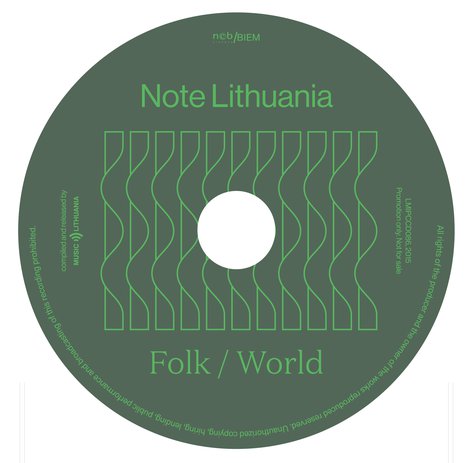Folk beyond time and borders
- Sept. 29, 2015
Ugnius Liogė, the head of Dangus Records, said this year in an interview for the cultural show of the Lithuanian national television that Mėnuo Juodaragis – the chief event he produces and the biggest post-folk festival in Lithuania (and perhaps the Baltics) with a strong cult following – is in constant search for new forms that would give newly relevant meanings to the tradition and expand its scope. The tradition is based on certain rituals, of course, but the essence of a ritual is repetition that nevertheless carries the message of the ritual to new generations and new audiences. Perhaps this is why the line-up of this year’s festival was by far the most diverse ever, and in a sense the content of this compilation comes very close to it.
To be sure, such expansion has not only supporters but also opponents, and the reactions to a folk compilation like this may be very divided. To some people the inclusion of electronic artists, for instance, will look like a sacrilege, while others will welcome it as a sign of open-mindedness and progressive thinking. In the end, it is a matter of attitude and personal taste. I myself would not say that everything included here is equally interesting or has a subjective resonance, but in general this diversity makes the CD something altogether different from a usual folk music anthology, and for this reason appealing to a considerably wider – and younger – audience. I imagine that in a few years a compilation like this could be even more inclusive, and feature music that does not even use direct references to the Lithuanian folk tradition, but still has a very strong archaic atmosphere in its themes and instrumentation, such as contemporary post-industrial electronica and neofolk. After all, it is obvious that the artists in that scene were heavily influenced by ephemeral ethnic roots among other things.
The artists featured on Note Lithuania Folk/World 2015 take traditional inspirations in very different directions and form a wide eclectic network of visions of what (Lithuanian) folk music might sound like in a global context today. Some, like Merope, Solo & Indrė, Saulius Petreikis or Justina Mileškaitė, place it in a meditative multi-instrumental world music context, which proves that it is both essentially timeless and functions perfectly well beyond clear national borders. It would also probably be safe to say that this type of trans-ethnic world music currently enjoys the broadest audience compared to other folk-related forms, and is also prominently based on cross-genre collaborations.A handful of artists stick to somewhat more conventional interpretations of authentic Lithuanian folk music, which is also important as it provides a certain point of origin that ties the CD’s other offerings together. These include Ritingo, Rytis Ambrazevičius, Esatis and the Tabalai project, all marked by fidelity to the source but also fairly modern arrangements that make their compositions something more than just reconstructions of traditional songs and melodies. While the folk-rock of Esatis and Ritingo sounds more familiar, the rawness of the pieces by Ambrazevičius and Tabalai is more surprising and creates an interesting counterpoint.
Another part of the tracks follows the quite established route of ethnojazz/fusion, a genre with a longstanding tradition of its own. Alongside Algirdas Klova, a well-known proponent of this form, the CD features some newer names that are not yet mentioned so often – Virsmas, In Albedo and Jorė Remixed (a collaboration between the folk ensemble Jorė and three active young jazz instrumentalists). The latter ones prefer the kind of laidback, groovy and electric sound evocative of dimly lit contemporary jazz clubs, while Klova’s dynamic piece is more suitable for more traditional jazz festivals. The folk element seems to serve here primarily as an inspiration and a starting point for building rhythmic and melodic structures more specific to jazz.
The contribution of the collective/project called Rasa Rasa, comprised of a number of Lithuanian female folk singers and New York-based instrumentalists, including the famous enfant terrible Dalius Naujokaitis, sounds like nothing else on the compilation. Actually, it sounds precisely as that – as an explosive collision between Lithuanian polyphonic singing and the gritty underground of NYC noise rock and free jazz. Although these sound as unlikely companions, it works surprisingly well in all its chaotic drive and raw energy. It might even offend someone, but it is clearly a highlight of the whole CD.
Finally, for the part of the audience that is normally very far from all things folk, there are the three tracks which mix ambient/electronica/dub music with fragments of Lithuanian folk singing. In these, the folk elements are by and large an appropriation woven into the fabric of otherwise quite recognisable and conventional contemporary electronic sound, and this section of the compilation’s content would not be my first choice, but I know that it has its sizeable audience, and perhaps it is very logical that such forms exist as well. After all, different groups of people have different ways of approaching the same thing – the vital undercurrent that runs through epochs and feeds the present-day culture despite being ages old.
Jurij Dobriakov

